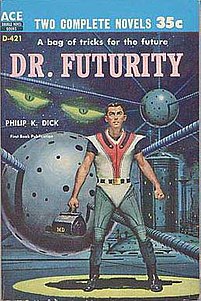Plot
Dr. Jim Parsons is a physician born in 1980 and living in 2012. Abruptly, he undergoes involuntary time travel to 2405 and finds that his profession is treated with disdain. In the future, the population is static, with no natural births; only a death can cause the formation of a new embryo. The result is a society ambivalent toward death, as controlled genetics ensures that each successive generation better benefits the human race as a whole. By killing off the weak and the malformed, poverty and disease are eliminated, and humanity has an optimal chance for survival. Moreover, a single race derived from a mix of races controls this future world, as white men had become extinct centuries earlier.
After Parsons cures a dying woman (not knowing that this is considered a heinous crime in this time period), Chancellor Al Stenog exiles him to Mars, but the spaceship is intercepted en route, and Parsons is returned to a deserted Earth far in the future. On finding a marker with instructions on how to operate the time travel controls on the spaceship, he is directed to a Native American-style tribal lodge, where he must perform surgery to hopefully restore the life of a cryogenically suspended time traveler, Corith, subsequent to the latter's death from an arrow wound 35 years earlier. Parsons extracts the missile but it later mysteriously rematerializes in Corith's body.
To resolve this situation, Parsons travels with Corith's relatives back to Corith's previous assignment in 1579 on the Pacific Coast of North America, where Corith was to kill Sir Francis Drake in order to change history and preserve the Native American way of life, avoiding their subjugation by European colonial powers. While observing the assassination attempt on Drake, Parsons realizes that Drake is actually Chancellor Stenog. It seems that Stenog, in an ironic twist of fate, has taken Drake's place long enough to ensure that Corith's mission fails. Parsons tries to warn Corith, but Corith discovers that Parsons is a disguised white man and attacks him. In the ensuing struggle, Parsons inadvertently stabs Corith in the heart with one of the arrow replicas that were intended to make it appear that Drake was killed by a Native American of that period.
In retribution, Parsons is left stranded by Corith's relatives in 1597, a year in which the European explorers had removed themselves for many years to come. But Parsons is quickly rescued by Loris, Corith's daughter, when she has a change of heart after learning that she is pregnant with Parsons' child.
While briefly back in 2405, Parsons realizes that the reason the arrow mysteriously reappeared in Corith's chest after he'd removed it was because he had apparently murdered him for a second time to cover his own tracks. If Corith were to recover, he would have revealed that it was Parsons who killed him, and an unwitting Parsons from slightly earlier would have been left helpless at the hands of Corith's relatives. As he stands over Corith, ready to kill him for a second time, he decides against it and flees. But a nagging curiosity obliges him to return yet again. He sees two unknown people kill Corith with the second arrow to the heart. Parsons discovers that the murderers are the children he will one day have with Loris, traveling back to 2405 from an even more distant future.
His children take Parsons forward in time to meet with Loris again, and he struggles with the decision to return to 2012. Eventually he goes back to the same day that he left and to the doting wife who saw him off earlier that morning. He sets about his old life with a new task at hand. The novel closes with him designing the stone marker that will eventually save his life on that desolate future Earth.

Poul William Anderson was an American science fiction author who began his career in the 1940s and continued to write into the 21st century. Anderson authored several works of fantasy, historical novels, and short stories. His awards include seven Hugo Awards and three Nebula Awards.

Life, the Universe and Everything is the third book in the five-volume Hitchhiker's Guide to the Galaxy science fiction "trilogy" by British writer Douglas Adams. The title refers to the Answer to Life, the Universe, and Everything.

Rocannon's World is a science fiction novel by American writer Ursula K. Le Guin, her literary debut. It was published in 1966 as an Ace Double, along with Avram Davidson's The Kar-Chee Reign, following the tête-bêche format. Though it is one of Le Guin's many works set in the universe of the technological Hainish Cycle, the story itself has many elements of heroic fantasy. The hero Gaveral Rocannon encounters lords who live in castles and wield swords, and other races much like fairies and gnomes, in his travels on a backward planet.
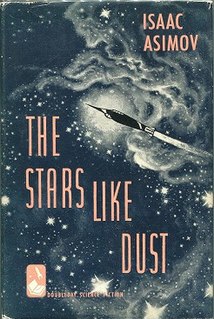
The Stars, Like Dust is a 1951 science fiction mystery book by American writer Isaac Asimov.

2001: A Space Odyssey is a 1968 science fiction novel by British writer Arthur C. Clarke. It was developed concurrently with Stanley Kubrick's film version and published after the release of the film. Clarke and Kubrick worked on the book together, but eventually only Clarke ended up as the official author. The story is based in part on various short stories by Clarke, including "The Sentinel". By 1992, the novel had sold three million copies worldwide. An elaboration of Clarke and Kubrick's collaborative work on this project was made in the 1972 book The Lost Worlds of 2001.
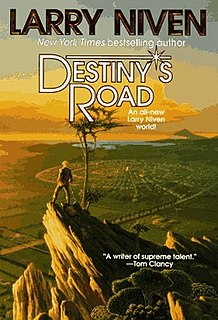
Destiny's Road is a science fiction novel by American writer Larry Niven, first published in 1998. It follows Jemmy Bloocher's exploration of Destiny's Road, a long scar of once-melted rock seared onto the planet's surface by a spaceship's fusion drive. Jemmy is descended from the original Destiny colonists, who were stranded when their landing craft deserted them.
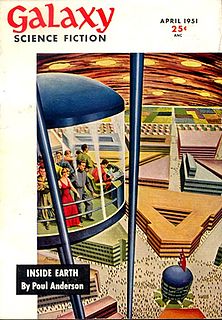
"The Marching Morons" is a science fiction story by American writer Cyril M. Kornbluth, originally published in Galaxy in April 1951. It was included in The Science Fiction Hall of Fame, Volume Two after being voted one of the best novellas up to 1965.
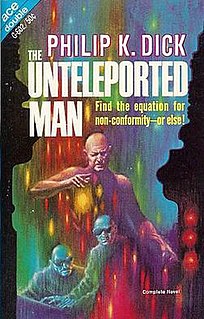
The Unteleported Man is a 1966 science fiction novel by American writer Philip K. Dick, first published as a novella in 1964. It is about a future in which a one-way teleportation technology enables 40 million people to emigrate to a colony named Whale's Mouth on an Earth-like planet, which advertisements show as a lush green utopia. When the owner of a failing spaceship travel firm tries to take the 18-year flight to the colony to bring back any unhappy colonists, powerful forces try to stop him from finding out the truth.

"Titans Tomorrow" is a storyline of a possible alternate future in the DC Comics Universe, from Teen Titans vol. 3 #17-19 (2005), by Geoff Johns and Mike McKone. The story arc has been collected as part of the Teen Titans: The Future is Now trade paperback.
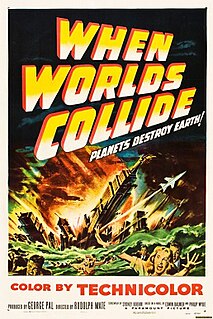
When Worlds Collide is a 1951 American science fiction disaster film, produced by George Pal, directed by Rudolph Maté, and starring Richard Derr, Barbara Rush, Peter Hansen, and John Hoyt. It was distributed by Paramount Pictures. The film is based on the 1933 science fiction novel of the same name, co-written by Philip Wylie and Edwin Balmer.
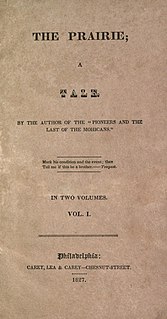
The Prairie: A Tale (1827) is a novel by James Fenimore Cooper, the third novel written by him featuring Natty Bumppo. His fictitious frontier hero Bumppo is never called by his name, but is instead referred to as "the trapper" or "the old man." Chronologically The Prairie is the fifth and final installment of the Leatherstocking Tales, though it was published before The Pathfinder (1840) and The Deerslayer (1841). It depicts Natty in the final year of his life still proving helpful to people in distress on the American frontier. The book frequently references characters and events from the two books previously published in the Leatherstocking Tales as well as the two which Cooper wouldn't write for more than ten years. Continuity with The Last of the Mohicans is indicated by the appearance of the grandson of Duncan and Alice Heyward, as well as the noble Pawnee chief Hard Heart, whose name is English for the French nickname for the Delaware, le Coeur-dur.
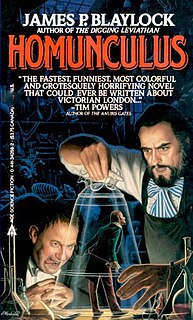
Homunculus is a comic science fiction novel by American writer James P. Blaylock. It was published in 1986. It was the second book in Blaylock's loose steampunk trilogy, following The Digging Leviathan (1984) and preceding Lord Kelvin's Machine (1992). The book was originally published as an Ace paperback by the Berkeley Publishing Group and is included in the Adventures of Langon St. Ives collection.

Epenow was a Nauset from Martha's Vineyard, Massachusetts who became an early symbol of resistance to English explorers and slavers in the early 17th century. Captured by an English expedition, he was taken to England, but was returned on a subsequent voyage to serve as interpreter. He then made his escape, and warned others to be wary of the English.

Terminal is the sixth and final novel in the Tunnels series, published in UK on 6 May 2013.
"The Doctor" is the fifth episode of the second season of the American ABC fantasy/drama television series Once Upon a Time, and the show's 27th episode overall, which aired on October 28, 2012.

Quest for the Future is a science fiction novel by Canadian-American writer A. E. van Vogt. It was first published by Ace Books in 1970.
Since the characters inception in the 1960s Spider-Man has appeared in several forms of media, including standalone novels and book series.
